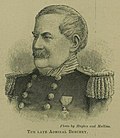File:HMS 'Erebus' passing through the chain of bergs, 1842 RMG BHC3654.tiff

Original file (7,200 × 5,067 pixels, file size: 104.38 MB, MIME type: image/tiff)
This is a file from the Wikimedia Commons. Information from its description page there is shown below.
Commons is a freely licensed media file repository. You can help.
Summary
| Richard Brydges Beechey: HMS 'Erebus' passing through the chain of bergs, 1842
|
||||||||||||||||||||||||
|---|---|---|---|---|---|---|---|---|---|---|---|---|---|---|---|---|---|---|---|---|---|---|---|---|
| Artist |
|
|||||||||||||||||||||||
| Author |
Admiral Richard Brydges Beechey |
|||||||||||||||||||||||
| Title | ||||||||||||||||||||||||
| Object type |
painting object_type QS:P31,Q3305213 |
|||||||||||||||||||||||
| Description |
English: HMS 'Erebus' passing through the chain of bergs, 1842 This painting captures a dramatic scene from Rear-Admiral Sir James Clark Ross’s Antarctic expedition of 1839-43. Ross was given command of HMS ‘Erebus’ and HMS ‘Terror’ to carry out a magnetic survey in the Antarctic region. The expedition resulted in various discoveries, including the area subsequently known as the Ross Ice Barrier. The artist portrays the Antarctic as a world of grandeur and the sublime: the night scene, the agitated waves and the towering icebergs dwarfing and isolating the man-made ships, eerily lit by flashes of light on their dangerous passage through the pack with broken masts. By the mid-19th century, depictions of both the Arctic and the Antarctic held a fascination for the art-loving audience, and it is likely the painting was executed soon after Ross published his travel narrative “A Voyage of Discovery and Research to Southern and Antarctic Regions” in 1847. The artistic formula employed here links the painting to the tradition of the sublime natural catastrophe as it had appeared in European painting since the late 18th century. More precisely, the scene refers to an episode in the travel book (vol. II, pp. 217-22) and to the print by JE (John Edward) David, first mate of HMS Terror, accompanying it, documenting and defining its most dramatic and glorious moment. After the collision of the two ships on the March 12, 1842, which crippled the ‘Erebus’s’ masts, the latter escaped the life-threatening gales of a storm by moving into a narrow channel in the chain of bergs. The crew could just make out the ‘Terror’s’ light, reassuring them of their fellow sailors’ safety, when they experienced the natural phenomenon of what they believed to be the Aurora australis. The appearance of the bright light marks the end of the peril and in the narrative is followed by a reference to a collective prayer. The painter, assumed to be Richard Brydges Beechey, has adhered to Davis’s composition and at the same time heightened the drama of the scene according to the academic rule, matching and surpassing the written account. Admiral Richard Brydges Beechey (1808-1895) was the son of the portrait painter Sir William Beechey. He entered the Royal Naval College in 1821 and probably trained under the drawing master Jon Christian Schetky. During his naval career he also took part in a voyage of discovery taking him to the Pacific. Beechey retired from the Navy in 1864, but continued to paint and to exhibit at the Royal Academy. He specialized in maritime subjects (BHC1270). |
|||||||||||||||||||||||
| Date |
1860 date QS:P571,+1860-00-00T00:00:00Z/9 |
|||||||||||||||||||||||
| Medium |
oil on canvas |
|||||||||||||||||||||||
| Dimensions | Painting: 788 mm x 1118 mm; Frame: 1070 x 1410 x 110 mm, 27.8kg | |||||||||||||||||||||||
| Collection |
institution QS:P195,Q7374509 |
|||||||||||||||||||||||
| Current location | ||||||||||||||||||||||||
| Accession number |
BHC3654 |
|||||||||||||||||||||||
| References | ||||||||||||||||||||||||
| Source/Photographer | http://collections.rmg.co.uk/collections/objects/15127 | |||||||||||||||||||||||
| Permission (Reusing this file) |
The original artefact or artwork has been assessed as public domain by age, and faithful reproductions of the two dimensional work are also public domain. No permission is required for reuse for any purpose. The text of this image record has been derived from the Royal Museums Greenwich catalogue and image metadata. Individual data and facts such as date, author and title are not copyrightable, but reuse of longer descriptive text from the catalogue may not be considered fair use. Reuse of the text must be attributed to the "National Maritime Museum, Greenwich, London" and a Creative Commons CC-BY-NC-SA-3.0 license may apply if not rewritten. Refer to Royal Museums Greenwich copyright. |
|||||||||||||||||||||||
| Identifier InfoField | id number: BHC3654 | |||||||||||||||||||||||
| Collection InfoField | Oil paintings | |||||||||||||||||||||||
Licensing
|
This is a faithful photographic reproduction of a two-dimensional, public domain work of art. The work of art itself is in the public domain for the following reason:
The official position taken by the Wikimedia Foundation is that "faithful reproductions of two-dimensional public domain works of art are public domain".
This photographic reproduction is therefore also considered to be in the public domain in the United States. In other jurisdictions, re-use of this content may be restricted; see Reuse of PD-Art photographs for details. | |||||
Captions
Items portrayed in this file
depicts
File history
Click on a date/time to view the file as it appeared at that time.
| Date/Time | Thumbnail | Dimensions | User | Comment | |
|---|---|---|---|---|---|
| current | 22:47, 22 September 2017 |  | 7,200 × 5,067 (104.38 MB) | Fæ | Royal Museums Greenwich Oil paintings (1860), http://collections.rmg.co.uk/collections/objects/15127 #1292 |
File usage
The following 3 pages use this file:
Metadata
This file contains additional information, probably added from the digital camera or scanner used to create or digitize it.
If the file has been modified from its original state, some details may not fully reflect the modified file.
| Width | 7,200 px |
|---|---|
| Height | 5,067 px |
| Bits per component |
|
| Compression scheme | Uncompressed |
| Pixel composition | RGB |
| Image data location | 140 |
| Number of components | 3 |
| Number of rows per strip | 5,067 |
| Bytes per compressed strip | 109,447,200 |
| Data arrangement | chunky format |


